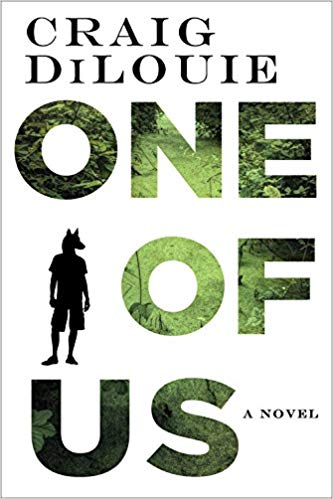Craig DiLouie, One of Us
reviewed by Alison McBain

One of Us Publisher: Orbit Date: July 17, 2018 Length: 400 pages ISBN: 0316411337; 9780316411332 |
Some books linger long after being read, some books make you uncomfortable by illuminating the dark side of humanity, and some books are allegories for the relevant social and political issues of today. And some books, like One of Us by Craig DiLouie, cross all of these topics and themes.
The book starts out with a common science fiction premise - human mutation. An STD has caused a string of pregnancies that result in “plague kids” being born, kids that are considered physically repugnant to “Normals.” They might be covered in fur, for example, or have an upside-down face, or be superhumanly smart but with an apelike appearance.
The kids both have legal names given to them at birth and names given to them by their fellow plague kids, based on their appearance or abilities. This aspect of the story seems similar to a favorite comic series of mine, X-Men. However, where the X-Men have amazingly useful powers and great physical attractiveness, many of the plague kids have characteristics that may seem useless rather than useful and “ugly” appearances.
This latest generation of infected kids were separated from their families at birth — often willingly on the families’ parts, who saw their offspring as undesirable and a social black mark against them — and stuck into Homes: places run by the mentally unstable and criminals who abuse and sometimes kill their charges. Nominally under government supervision, these Homes are terrible places in remote locations far away from Normals, so both Normals and plague kids grow up mostly separate from each other.
There is a whole cast of characters on both sides of the equation, and each one has a variety of motivations. For example, there’s the plague kid Dog, who wants to believe the best about Normals and their intentions despite evidence to the contrary. Then there’s Brain, who prophesizes that a revolution is coming as soon as the plague kids grow up and realize they deserve more than the short end of the stick.
On the Normal side, there’s teenager Sally, who sympathizes with the plight of the plague kids, and her friend Jake, who is trying to lead a revolution to teach people to treat the kids as human beings. At the same time, Jake’s father is leading the charge to condemn them. There’s also Gaines, one of the teachers at the Home, who sees both plague kids and women as subhuman and treats them accordingly.
Most of the plague kids are in their early teens, just past or starting puberty. When puberty hits, that’s when strange things start to happen that strike a match to the powder keg of us versus them.
The reason for the change is that plague kids aren’t just ugly Normals. Many of them develop amazing powers once past childhood. And if Normals can’t learn to start treating them as human, the kids might become the monsters that Normals always feared them to be.
This book has coming-of-age elements and a dystopian outlook, although I wouldn’t call it a complete dystopia. It touches upon issues of race and class, the haves and have-nots, and the religious and moral implications of how humanity can be defined. It does a good job of creating parallels to relevant social, political, and cultural issues of today, including both positive and negative examples of bias and behavior.
If there’s one criticism I might have about the premise, it’s that the culture of the book seems to have more of a 1950s feel than 1984, when the book is supposed to be set. The explanation of why — financial and cultural stagnation from dropping birth rates after the plague hits — comes later in the story, and perhaps could have been mentioned a bit earlier. I felt a bit of a disconnect each time the 1980s references were mentioned, when the characters behaved as if time had stopped a couple of decades earlier.
But that’s a minor detail and wouldn’t bother most readers. The writing itself is intriguing, the voice of the narrative and dialogue compelling, and the story unfolds with both heartbreaking and emotional inevitability.
The plot is as complex as the characters, and there are tales of love and humor, wish fulfillment and broken dreams, heartbreak and redemption. This book gives nods to classical tales from which the author might have drawn inspiration - books like Lord of the Flies, 1984, Of Mice and Men, The Metamorphosis, and probably a slew of others.
This novel feels thematic and important to the times we live in by drawing on popular culture, classic literature, and today’s social and political issues. I’d definitely recommend it; you’ll be thinking about this twisted and complex world and its characters long after you put the book down.
Copyright © 2018 by Alison McBain

